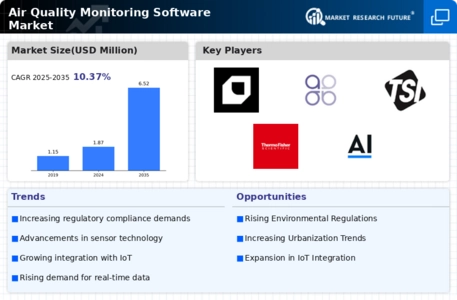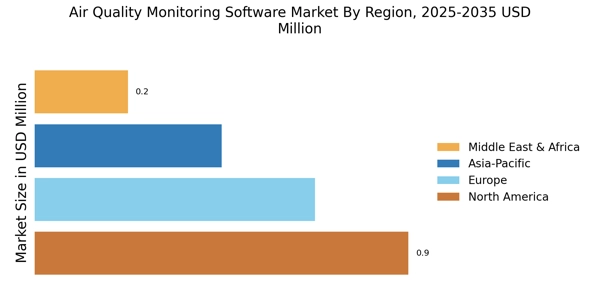Public Health Initiatives
Public health initiatives aimed at reducing air pollution are playing a crucial role in driving the Air Quality Monitoring Software Market. Health organizations and governments are increasingly recognizing the link between air quality and public health outcomes. Initiatives to monitor and improve air quality are being implemented to protect vulnerable populations, such as children and the elderly. These initiatives often involve the deployment of air quality monitoring systems to gather data that informs policy decisions and public awareness campaigns. As a result, there is a growing demand for sophisticated monitoring solutions that can provide accurate data and insights. The market is expected to grow as public health concerns continue to drive investments in air quality monitoring technologies.
Technological Advancements
Technological innovations are significantly shaping the Air Quality Monitoring Software Market. The integration of advanced sensors, data analytics, and cloud computing has revolutionized how air quality data is collected, analyzed, and disseminated. These advancements enable more accurate and real-time monitoring of air pollutants, which is crucial for effective decision-making. Furthermore, the rise of Internet of Things (IoT) devices facilitates seamless data integration and remote monitoring capabilities. As a result, organizations are increasingly adopting sophisticated air quality monitoring solutions to enhance their operational efficiency and compliance with regulatory standards. The market is expected to expand as these technologies become more accessible and affordable, potentially leading to a broader adoption across various sectors.
Increasing Environmental Awareness
The growing concern regarding environmental issues appears to be a primary driver for the Air Quality Monitoring Software Market. As individuals and organizations become more aware of the detrimental effects of air pollution on health and the environment, the demand for effective monitoring solutions intensifies. This heightened awareness is reflected in various studies indicating that air quality directly impacts public health, leading to increased healthcare costs. Consequently, governments and private entities are investing in air quality monitoring technologies to ensure compliance with environmental standards. The market is projected to witness substantial growth, with estimates suggesting a compound annual growth rate of over 10% in the coming years, driven by the need for real-time data and actionable insights.
Urbanization and Population Growth
The rapid pace of urbanization and population growth is a significant driver for the Air Quality Monitoring Software Market. As cities expand and populations increase, the demand for effective air quality management becomes more pressing. Urban areas often experience higher levels of pollution due to increased vehicular traffic, industrial activities, and construction. Consequently, municipalities are recognizing the need for robust air quality monitoring systems to assess pollution levels and implement mitigation strategies. This trend is likely to lead to increased investments in air quality monitoring technologies, as cities strive to create healthier living environments for their residents. Projections indicate that the urban air quality monitoring market could see substantial growth, reflecting the urgent need for effective solutions.
Regulatory Pressures and Compliance
Regulatory frameworks aimed at improving air quality are exerting considerable influence on the Air Quality Monitoring Software Market. Governments worldwide are implementing stringent regulations to combat air pollution, necessitating the adoption of monitoring solutions to ensure compliance. For instance, the establishment of air quality standards by environmental agencies mandates regular monitoring and reporting of air quality data. This regulatory pressure is driving organizations to invest in advanced monitoring systems that can provide accurate and timely data. The market is likely to experience growth as businesses seek to avoid penalties and enhance their sustainability practices. It is estimated that compliance-related investments in air quality monitoring could reach billions of dollars in the next few years.


















Leave a Comment